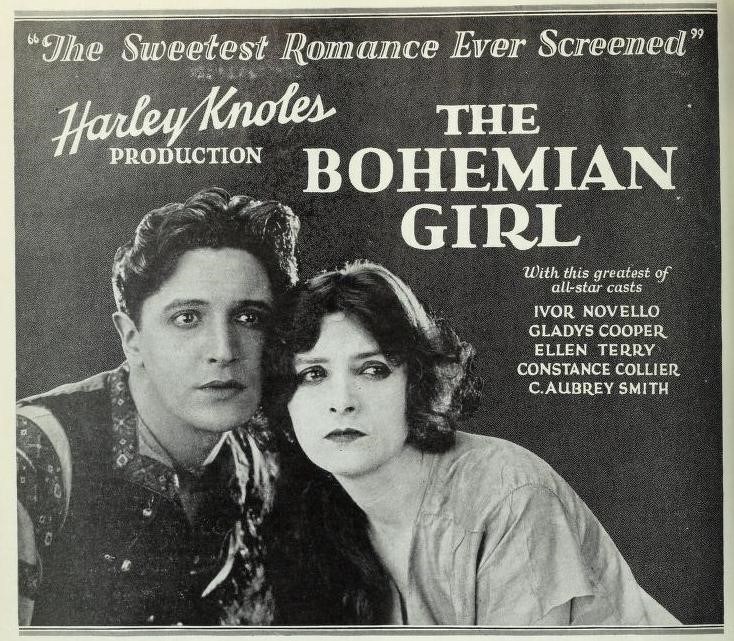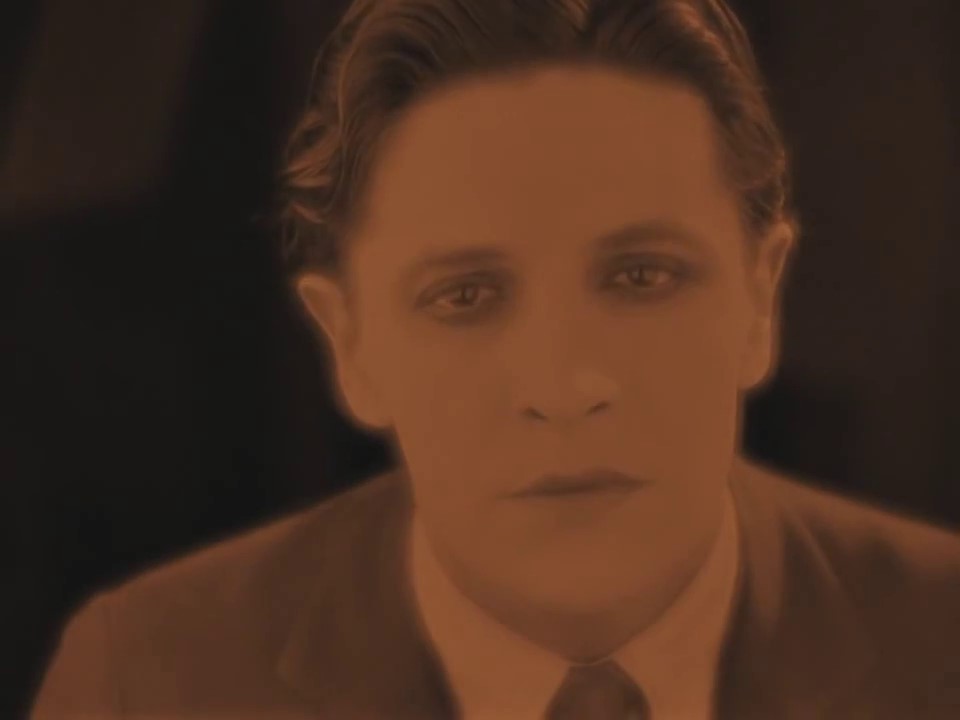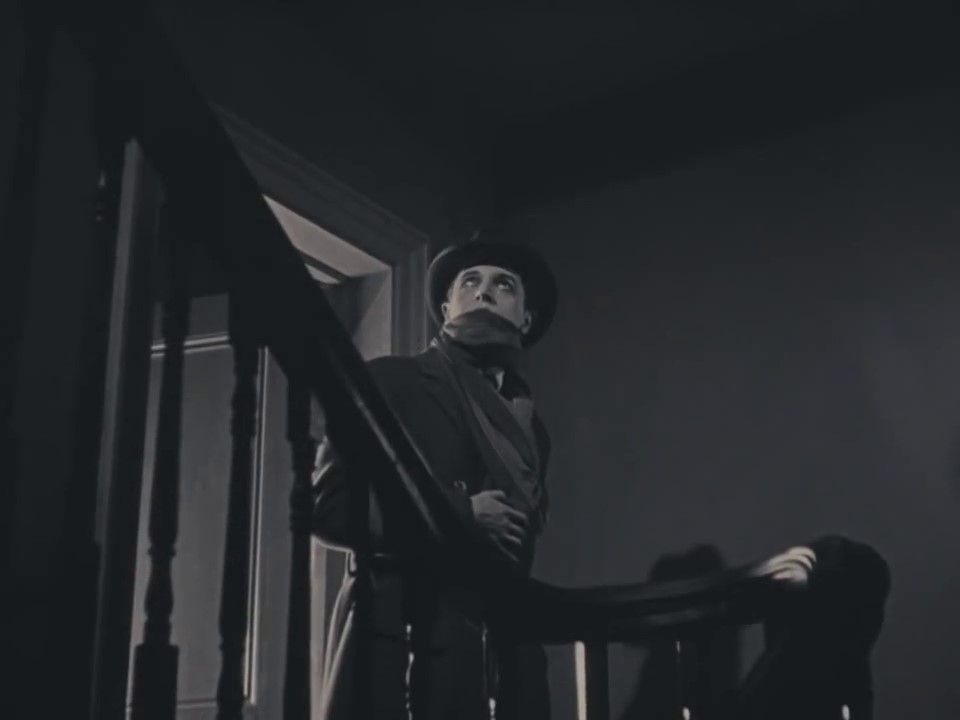Ivor Novello was the biggest male star of British cinema in the 1920s and early 1930s, starring in 22 films in a career that spanned 1919 to 1934.
The handsome Cardiff-born star – with his celebrated ‘classic profile’ – first rose to fame in 1914 as the composer of hit WWI anthem, ‘Keep the Home Fires Burning’, granting him a central place in British popular culture. This would be reinforced not only by his matinee-idol film roles, but his work as a playwright, actor-manager and composer of hit musicals until his death in 1951. Novello even had a couple of stints working in Hollywood; writing dialogue for Tarzan the Apeman (W.S. van Dyke, 1932) being one of the more curious additions to his filmography.

Ivor Novello and co-star Gladys Cooper in an advertisement for The Bohemian Girl (1922) from The Film Daily 10th June 1923 (Media History Digital Library)
Novello’s final stage musical was ‘Gay’s the Word’, an arguably knowing title that inspired the name of the UK’s oldest LGBTQ+ bookshop in central London. It is no secret now that Novello was gay (actor Bobbie Andrews was his partner of 35 years), and most of those in theatrical and film circles would have known. So too would many of his fans if they were able, or inclined, to recognise the signs.
It is not surprising that the gay identity of a star such as Novello was not explicitly discussed in public during his lifetime. Even today, coming out as LGBTQ+ is viewed by leading agents and producers, especially in Hollywood, as a career-restricting liability particularly for A-list players, although this is gradually changing. Back in the 1920s, although we can presume the population to include a similar proportion of queer people as now, there was no chance that Novello, like his Hollywood contemporary, Ramon Novarro, would be publicly ‘out’. However, in some ways, and particularly in the playful pages of the booming industry of fan-magazines, the secret could be hidden in plain sight.
As star studies scholars have observed, fan-magazines helped satisfy the desire of audiences to engage with their stars away from the screen, extending the mythic realm of cinema itself. There’s perhaps something about the heyday of silent cinema that fostered such myths, with those huge glowing close-ups in music filled auditoria inspiring the imagination. Cinemagoers might wonder what their favourite stars sounded like, about the life they lead away from the screen, and just who Ivor Novello might actually want to kiss when his mouth moves in to nearly consume the screen in that famous close-up from Alfred Hitchcock’s 1926 classic, The Lodger: A Story of the London Fog.

The setting of Hitchcock’s film brings us back to Bloomsbury, not far from the aforementioned bookshop, where we find other queer haunts, including those expressionistic fog-enshrouded streets in which the film is set. His character can be called ‘queer’ in many different ways, including his eccentrically nervous / camp behaviour, his sometimes-strange appearance which veers from a gaunt vampire-like figure to an immaculately dressed sophisticate. Then there’s his suspiciously unseen nocturnal life, the Lodger sneaking out into the streets at night.

The film’s intertitles are peppered with references to the Lodger not being ‘keen on the girls’ and one defence of the Lodger’s curious aversion to his landlady’s risqué paintings of Victorian belles: ‘even if he is a bit queer, he’s a gentleman’. The Lodger is hounded by the police and is attacked by a mob while handcuffed; a provocative motif Hitchcock later associated with a sexual fetish in his famous Hitchcock/Truffaut interview. Novello is made to suffer, and suffer beautifully, a trait of many of his roles where he is burdened with some strange secret that ensures that a conventional heterosexual dénouement falls persistently out of reach. But if Novello is queerly mannered in The Lodger, in whatever sense, it serves the noirish plot – Novello the homme fatal – and adds possibilities to this character and others.

The year The Lodger was first shown, Novello had established his own queer space in London, the Fifty-Fifty club in Soho. This was a sanctuary where theatrical folk could meet and dine, but one subjected to police raids on spurious charges. Press reports alluded to ‘a certain type’ who favoured the club, alerting us to the real reasons for those raids. That type, no doubt, included Novello’s contemporary, Noel Coward. Variety seems to think along those lines when helpfully explaining to its readers on 5th September 1928 that the two men were ‘close friends; and were members of what it termed ‘the same temperamental set in London’.
More direct is a line in the New York Times review of The Lodger on 11 June 1928 which really leapt from the page at me when I first started researching Novello. ‘There now enters Mr. Novello’, it opined, ‘looking pale and drawn and with a manner plainly saying that he very likely doesn’t like blondes at all’. What else can this ‘manner plainly saying’ be referring to but homosexuality? Notably here, the reviewer is referring to ‘Mr Novello’ rather than ‘The Lodger’, as if it’s something that Novello brings personally to the role.
Elsewhere in fan-magazines, as for other gay stars, one finds more coded comments on Novello’s excellent manners, his romantic and sensitive nature, and ubiquitous references to his devotion to his mother, as well as an admiration for strong and often fabulous women. When the ‘talkie’ remake of The Lodger (Maurice Elvey, 1932), also starring Novello was released in the US as The Phantom Fiend, Variety (24th April 1935) sneered at ‘the lip pursing of Ivor Novello’, who ‘directs suspicion towards himself by his queer antics’. The OED tells us that the word ‘queer’ as a reference to homosexuality had been in sub-cultural use at least since the 1890s, then becoming a mainstream slur before being reappropriated by the LGBTQ+ community a century later. Variety thus may, or may not, have had Novello’s sexuality in mind with this description, but in context it’s difficult to miss the innuendo, especially if you were a member of that aforementioned ‘temperamental set’.
Such oblique references, coding and stereotyping, does not always read as homophobic, even though the hushed circumstances is redolent of that context. Intentionally or not, such language made something visible, however opaquely, to audiences then, and to us now, like eddies in the heteronormative fog that continually conspires to obscure it.
Carefully articulating the sexual identity of stars could even be commercially expedient. Ronald Gregg, in his research on gay Hollywood heartthrob, William Haines, argues that there was a short period from the late 1920s where representing queerness was even seen to be of commercial advantage in Hollywood before the enforcement of the Production Code in 1934 shut things down once more.
In terms of those intertitles and apparently throwaway remarks we find in fan-magazines and newspapers, it’s too easy to permit heteronormative pressure to dismiss such references as reading ‘too much’ retrospectively, as if there were never any LGBTQ+ people in the past. There’s often a reason why such identities and desires were not openly declared and so had to be expressed a little more obliquely – queerly – so we should celebrate those traces and give them their proper place in history.
So when I sit down this LGBT+ History Month and watch the Lodger slipping out into the London fog, I’ll be thinking about the queer antics of all kinds that both he, and Ivor Novello, brought to silent cinema.
Michael Williams is author of Ivor Novello: Screen Idol (BFI Publishing, 2003), and has most recently written on Novello in Tamar Jeffers McDonald and Lies Lanckman eds., Star Attractions: Twentieth-Century Movie Magazines and Global Fandom (University of Iowa Press, 2019).
https://www.uipress.uiowa.edu/books/9781609386733/star-attractions
http://www.southampton.ac.uk/film/michael_williams
Screengrabs: The Lodger, Network Releasing, Blu-ray, 2012
For more information from the BFI on Ivor Novello see: http://www.screenonline.org.uk/people/id/448907/index.html

